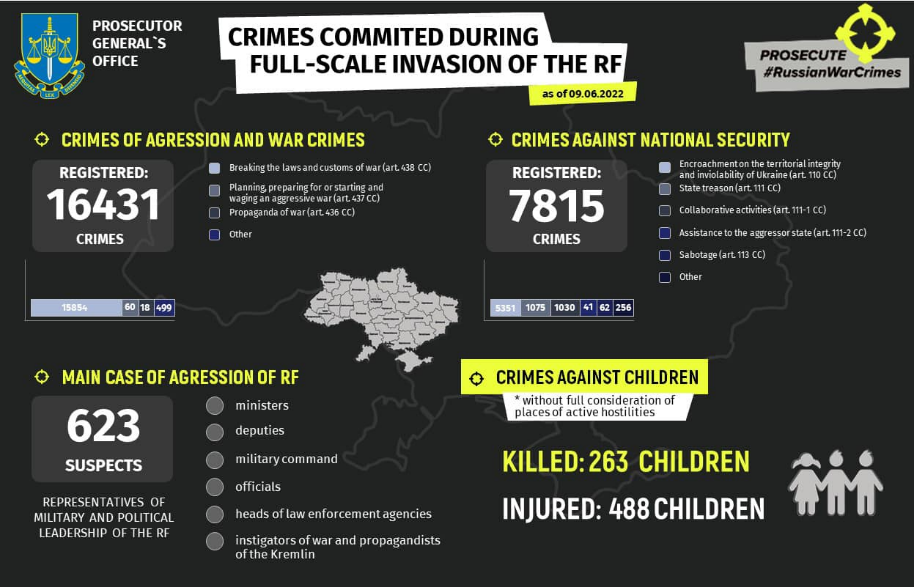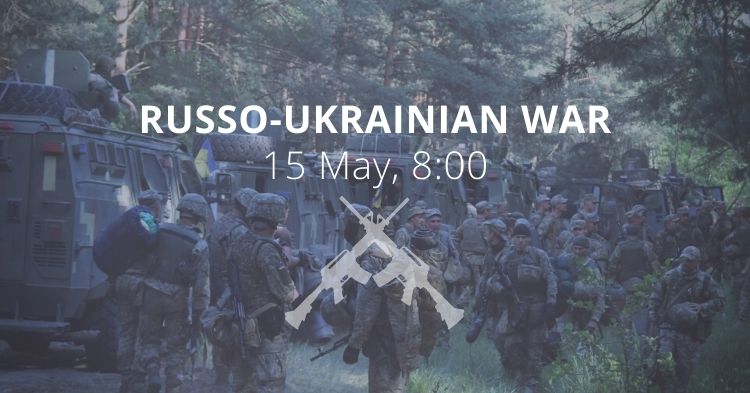Morning report day 106 – June 09
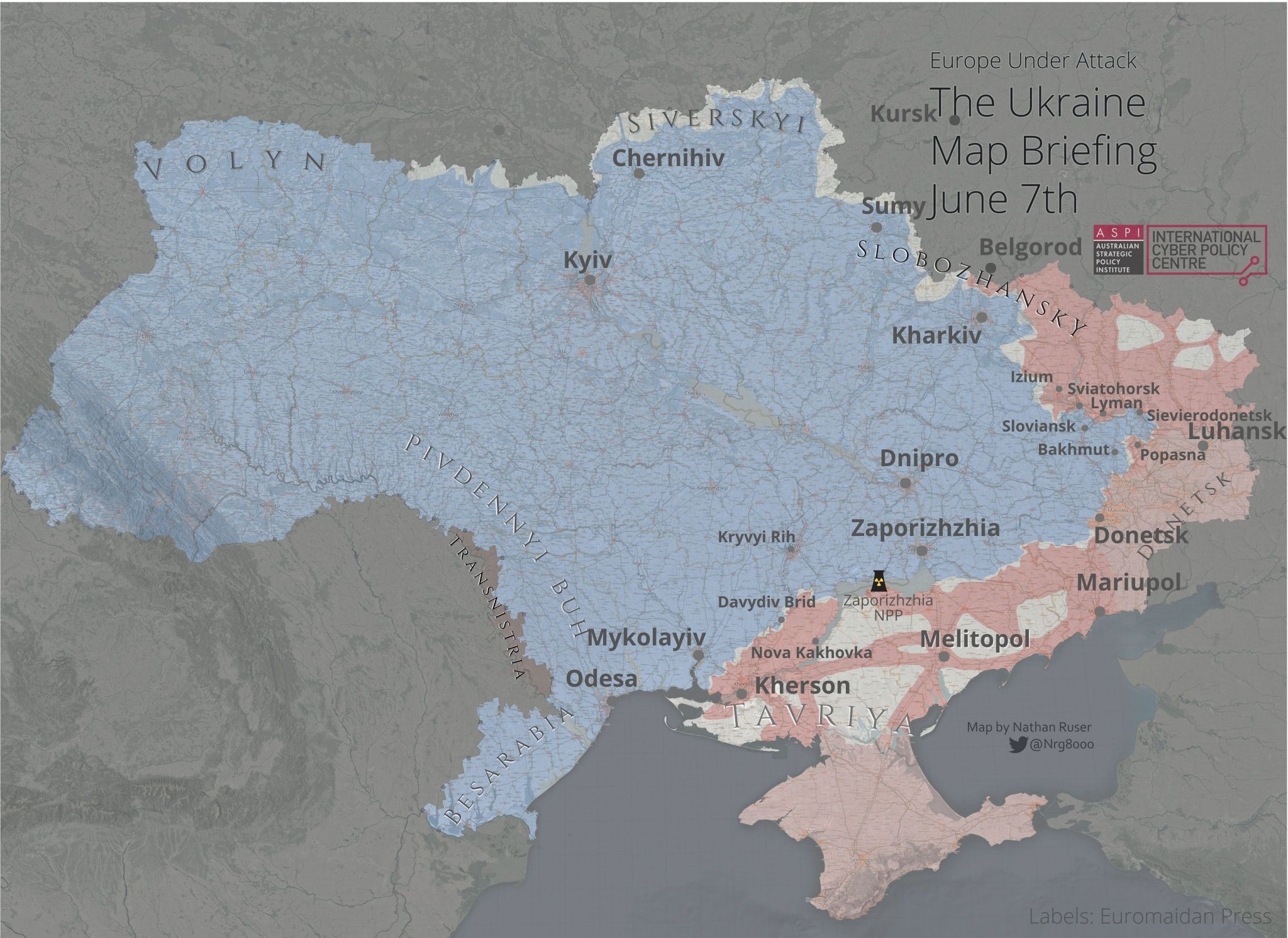
Luhansk Oblast. Fighting continues in Sievierodonetsk, where Ukrainians likely control a smaller part of the city. Also, Ukrainian Armed Forces continue to hold the front south of Lysychansk, in the area of Ustynivka - Toshkivka. This is a very important sector because the breakthrough here will open for Russians a direct path to Lysychansk, as a result of which the Ukrainian group in Sievierodonetsk will be encircled. The Bakhmut-Lysychansk route remains under Ukrainian control, and all Russian attempts to cut it off near the villages of Bilohoruvka-Nahirne have failed. To the north of the Popasna fighting continues on the outskirts of Komyshuvakha and near Vrubivka.
For an idea of exactly how much more elevated Lysychansk is... pic.twitter.com/rmv8ne41hg
— Nathan Ruser (@Nrg8000) June 8, 2022
Donetsk Oblast. Fighting continues along the entire line of contact, without much progress. Since the beginning of the war, the largest Russian success was to make wedges into the Ukrainian front north of Avdiivka. As the Russians were unable to capture the latter despite three months of frontal attacks, there is a suspicion that they will now try to surround it. However, as in the Luhansk Oblast, they are moving very slowly. At the same time, Russians likely continue preparation for a big assault on Sloviansk, although they are still about 30 kilometers from the city.
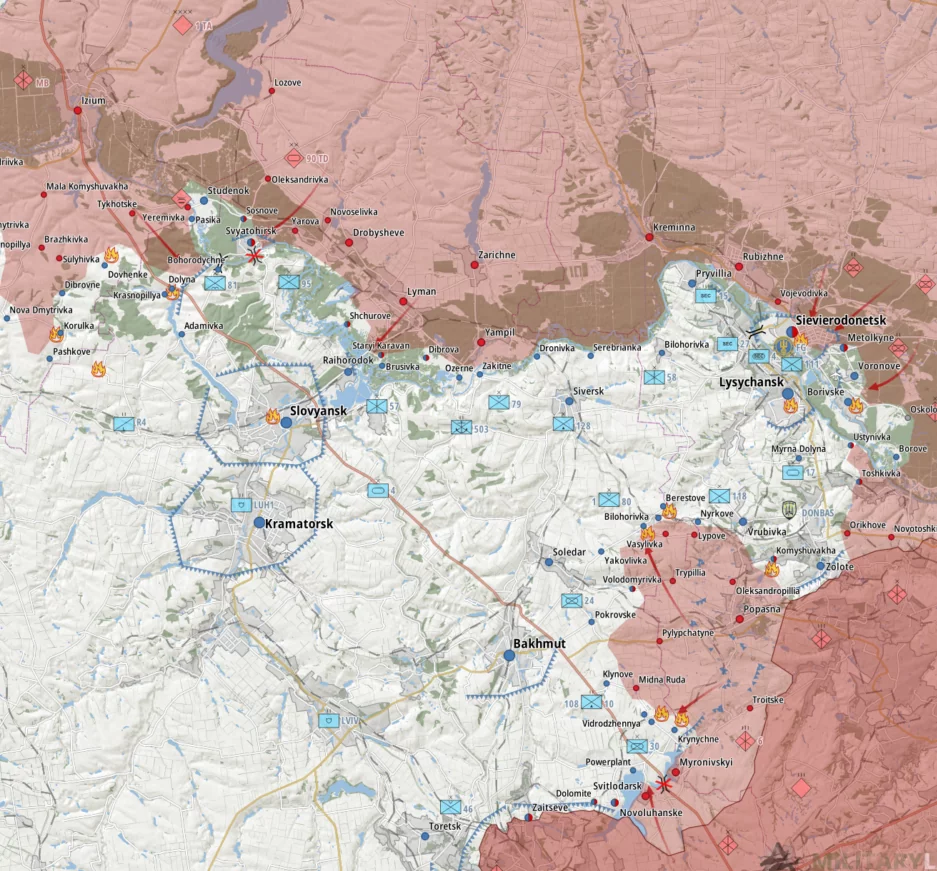
There is periodic news about mutual activity in the Kherson Oblast in the area of Davydiv Brid: about Ukrainian offensives and Russian counter-offensives. There is no reliable confirmation of this. What is known for sure is that Ukrainian Armed Forces are in positions in front of Bruskynske, on the route to Nova Kakhovka. Russians have turned this Bruskynske into a powerful stronghold and a Ukrainian frontal assault unpromising. Most likely, both sides are accumulating forces for further operations. Meanwhile, mutual artillery shelling and air raids continue.
Meanwhile, Russia develops plans for the gradual integration of the occupied parts of the Kherson and Zaporizhzhia oblasts. In the Zaporizhzhia Oblast, the first 500 passports are planned to be distributed on June 12, the "Day of Russia." Economic integration of Kherson farmers into the "economic model of Russia" is also planned. These steps indicate their goal - integration into the Russian Federation, without the formation of intermediate formations such as the "People's Republic of Kherson."
Information from the General Staff as of 06.00 09.06.2022, supplemented by its [18:00 assessment] is in the drop-down menu.
- As part of the inspection of combat readiness of units of the Armed Forces of the Republic of Belarus, the tasks of combating sabotage and reconnaissance groups of the conventional enemy are being worked out.
- [Individual units of the Republic of Belarus are being moved to permanent locations.]
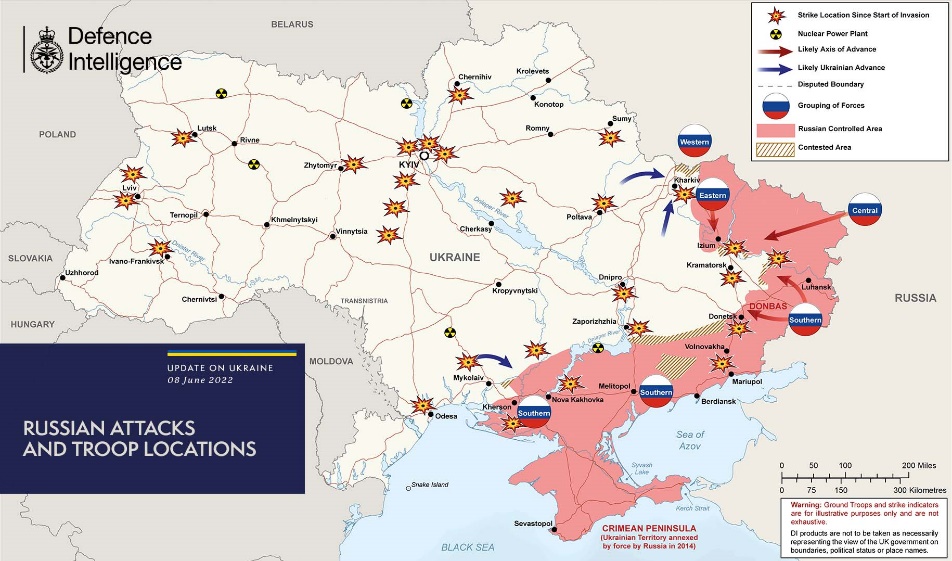
In the Siversky direction, Russian forces continue to provide enhanced protection of the Ukrainian-Russian border and fire mortars at civilian infrastructure in the border areas of Chernihiv and Sumy regions. [Yesterday, they fired mortars at civilian infrastructure in the areas of Khodyne, Ryzhivka and Velyka Pisarivka in the Sumy Oblast. In addition, Russian forces carried out provocative flights of army aircraft along the state border of Ukraine.]
[In the Slobozhansky direction, Russian forces concentrated their efforts on maintaining the occupied frontiers. Yesterday, they fired on civilian infrastructure in the areas of the settlements of Udy, Pytomnyk, Rtyshchivka, Ivanivka, Husarivka and others.]
- In the Kharkiv direction, Russian forces, to increase the stability of the defence, conducted engineering and fortification equipment positions and mining approaches. He is conducting intensive artillery shelling of our units to restrain the actions of Ukraine's defence forces. In addition, Russian forces fired on civilian infrastructure in the areas of the settlements of Stary Saltiv, Ruski and Cherkasy Tyshky, Korobochkine, Asiivka, Chepil and Uda.
- In the Sloviansk direction, Russian forces' efforts are focused on preparing for the continuation of the offensive in the direction of the settlements of Sloviansk and Barvinkove. Russian forces fired on civilian infrastructure in the areas of Dibrivne, Komyshuvakha and Kurulka. [Yesterday, the Ukrainian military successfully resisted Russian attempts to improve the tactical situation in the direction of the city of Sloviansk. The occupiers are concentrating their efforts on preparations for further offensive operations. Russian forces fired on civilian infrastructure in the areas of Vilne, Adamivka, Dolyna and Tetyanivka. Inflicted an airstrike on Sloviansk.]
- Using the results of the fire, the occupiers carried out offensive and assault operations near Bohorodychne and Dovhenke, and hostilities continue.
In the Donetsk direction, Russian forces, in addition to using artillery along the line of contact, fired a missile near the city of Kramatorsk.
- Russian forces did not take active action in the Lyman direction. It fired on Tetyanivka, Pryshyb and Serebryanka.
- In the Sievierodonetsk direction, Russian forces fired on our units with mortars, artillery and multiple rocket launchers. It fired on civilian infrastructure in the settlements of Sievierodonetsk, Lysychansk, Privillya, Ustynivka, Horske and Katerynivka. The occupiers launched an airstrike on Toshkivka and carried out an unsuccessful assault. In the direction of the village of Katerynivka, Ukrainian soldiers also inflicted losses on Russian forces. Russian forces retreated.
- [Yesterday, they fired on civilian infrastructure in the areas of the settlements of Privilka, Sievierodonetsk, Lysychansk, Voronove, Toshkivka, Hirske and others.]
- Russian forces continue their unsuccessful search for weaknesses in the defence of the city of Sievierodonetsk.
- In the Bakhmut direction, Russian forces fired at the positions of our units with artillery and MLRS near Komyshuvakha, Mykolayivka, Berestovo, Bilohorivka, Semyhirya and Mayorsky. It launched missiles and airstrikes in the settlements of Verkhnyokamyanka, Zolote, Berestove, Sloviansk and New York. Using the results of the fire, Russian forces conduct assault operations in the area of the settlements of Roty, Mykolayivka and Komyshuvakha.
- [Yesterday, Russian forces fired artillery at the settlements of Komyshuvakha, Vrubivka, Mykolaivka, Semyhirya, and New York. Enemy assault and army aircraft launched airstrikes near Nova Kamyanka, Pokrovske and Klynove. Defenders of Ukraine inflicted significant losses on the Russian occupiers in manpower and equipment during a Russian assault near Berestove.]
- In previous battles in this direction, Ukrainian defenders inflicted heavy losses on the occupiers and Russian forces were forced to withdraw to restore combat capability units of the 101st separate motorized infantry brigades of the 1st Army Corps.
- Russian forces did not conduct active hostilities in the Avdiivka, Kurakhiv, Novopavliv and Zaporizhzhia directions. To restrain the actions of our units, it fired artillery and mortars along the line of contact. [Yesterday, the Russian occupation forces fired on civilian infrastructure in the areas of the settlements of Kamyanka, Avdiivka, Pisky, Krasnohorivka, Vuhledar, Mykilske and others. Russian forces also used assault aircraft near Marinka and Kamyanka.]
[The situation in the Pivdennyy Buh direction remained without significant changes. Russian forces are trying to hold their ground and prevent the regrouping and strengthening of units of the Defense Forces.] Russian forces used artillery of various calibres in the areas of the settlements of Lyubymivka, Dobryanka, Bila Krynytsia, Shyroke, Bereznehuvate, Blahodatne, Lyubomyrivka and Tavriyske.
- [Yesterday, they used artillery in the areas of Velyka Kostromka, Lyubomyrivka and Novomykolayivka, and assault and army aircraft in the areas of Oleksandrivka, Knyazivka and Novodanylivka.]
- To improve the tactical situation, Russian forces are preparing to force water obstacles. Conducted air reconnaissance of UAVs. It plans to strengthen motorized infantry units with tank companies on the T-62. In addition, it deployed units of artillery and MLRS, as well as Tactical Operational Missile Complex "Tochka-U" 9K79 (SS-21 Scarab).
Over the past 24hrs, the defenders of Ukraine in the Donetsk and Luhansk areas repulsed seven enemy attacks and destroyed three tanks, two armoured combat vehicles and four units of enemy vehicles. Air defence units shot down six Orlan-10 unmanned aerial vehicles.
According to the available information, the personnel of the 15th separate motorized infantry brigade of the 2nd Combined Arms Army of the Central Military District suffered significant losses in the fighting on the territory of Ukraine. Approximately 800 dead and about 400 wounded. In total, about 1,800 servicemen from the brigade took part in the hostilities on the territory of Ukraine.
[In the temporarily occupied territories of Ukraine, the occupiers continue to carry out measures of the administrative and police regime, conduct searches of civilians, loot and destroy local infrastructure.]”
Russians control most of Sievierodonetsk, fighting continues in the city, Ukrainska Pravda
reports. The head of the Luhansk Oblast Military Administration said that the invaders control most of Sievierodonetsk. Fighting is taking place only on the streets inside the city, Head of the Luhansk Oblast Military Administration, Serhii Haidai, wrote on Facebook. According to Haidai, more than 90% of the region is temporarily under Russian occupation. At the same time, Lysychansk is completely under Ukrainian control.
Street battles are ongoing in Sievierodonetsk, Ukraine controls industrial area - RegHead Haidai
Russians scorch ground with artillery & then try to assault; if Ukraine gets western artillery, it can retake city in "2-3 days" https://t.co/Ziiw2pJepY
— Euromaidan Press (@EuromaidanPress) June 9, 2022
The situation in Mykolaiv is now more dangerous than two weeks ago, Ukrinform reports. "Now the situation is even more dangerous than it was two weeks ago because the city is under non-stop shelling. We advised two districts of the city to move to another area. But I don't know how many people listened to that, [Vitaliy Kim, head of the Mykolaiv Regional Military Administration,] said.
According to him, more than 3,700 civilian facilities in the city have been damaged or destroyed, and this number is growing every day. The day before yesterday, one of the largest terminals in Ukraine was destroyed, a fire broke out there and it was extinguished for two days, he said. Kim also said that more than 300 civilians had been killed during the war, including two of them in the last 24 hours.”
Russia deploys Iskanders near Kherson, Ukrainska Pravda reports, "There is still a threat of enemy missile strikes from the territory of the Autonomous Republic of Crimea on military and civilian facilities on the territory of Ukraine, according to Olexander Motuzniak, spokesperson for the Ministry of Defence. In particular, the Russian aggressors have deployed an Iskander-M missile system in the area near the town of Milkovodne [8 km away from the administrative border with Kherson Oblast]."
Since the start of the war, Ukrainian planes carried out more than 1,100 airstrikes on Russian Forces, Ukrainska Pravda reports. "As of today, more than 1,100 group air strikes on columns of equipment, positions, manpower and logistics centres belonging to the Russian occupiers have been carried out by attackers and bombers of the Air Force of the Armed Forces of Ukraine since the beginning of the full-scale invasion of Ukraine, [Press Service of the Air Force Command states].”
- Fighting continues in the Sievierodonetsk pocket but, in the last 48 hours, Russia’s Eastern Group of Forces (EGF) have also likely increased their efforts to advance to the south of Izium.
- Russia’s progress on the Izium axis had remained stalled since April after Ukrainian forces made good use of the terrain to slow Russia’s advance. Russia has likely attempted to reconstitute EGF after they suffered very heavy casualties in the failed advance on Kyiv, but its units likely remain understrength.
- Russia likely seeks to regain momentum in this area in order to put further pressure on Sievierodonetsk and to give it the option of advancing deeper into the Donetsk Oblast.
- [Yesterday] Russia continues to attempt assaults against the Sievierodonetsk pocket from three directions although Ukrainian defences are holding. It is unlikely that either side has gained significant ground in the last 24 hours.
- While Russia is concentrating its offensive on the central Donbas sector, it has remained on the defensive on its flanks. Ukrainian forces have recently achieved some success by counter-attacking in the south-western Kherson region, including regaining a foothold on the eastern bank of the Ingulets River.
- With the frontage of the occupied zone stretching for over 500km, both Russia and Ukraine face similar challenges in maintaining a defensive line while freeing up capable combat units for offensive operations.
- In the occupied Kherson region, Russia is forcibly aligning its administration with that of the Russian Federation by introducing the Russian rouble as legal tender and employing Russian teachers to introduce the Russian curriculum and language to schools.
As of Thursday 9 June, the approximate losses of weapons and military equipment of the Russian Armed Forces from the beginning of the war to the present day:
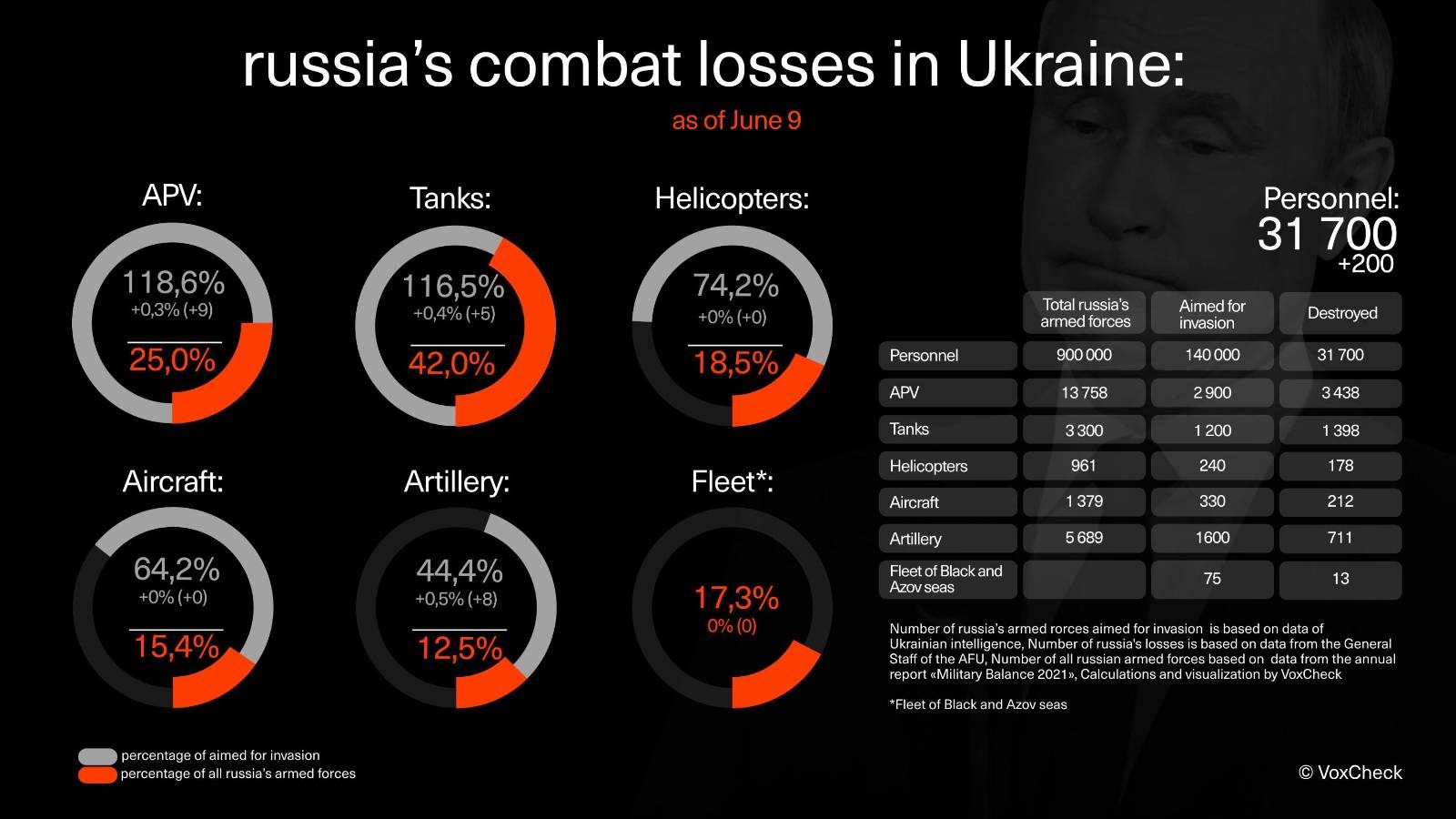
- Personnel – more than 31700 (+200),
- Tanks – 1398 (+5),
- Armoured combat vehicles – 3438 (+9),
- Artillery systems – 711 (+8),
- Multiple rocket launchers –MLRS - 213 (+0),
- Air defence means – 96 (+0),
- Aircraft - 212 (+0),
- Helicopters - 178 (+0),
- Automotive technology and fuel tanks – 2421 (+15),
- Vessels/boats - 13 (+0),
- UAV operational and tactical level – 562 (+3),
- Special equipment – 53 (+0),
- Mobile SRBM system – 4 (+0),
- Cruise missiles – 125 (+0)
Russian enemy suffered the greatest losses (of the last day) in the Bahmut direction.
Humanitarian
Millions of refugees from Ukraine have crossed borders into neighbouring countries, and many more have been forced to move inside the country. The escalation of conflict in Ukraine has caused civilian casualties and destruction of civilian infrastructure, forcing people to flee their homes seeking safety, protection and assistance the UNHCR reports. They need protection and support. As of 7 June:
Individual refugees from Ukraine recorded across Europe: 4,816,923
- Belarus, Hungary, Republic of Moldova, Poland, Romania, Russian Federation, Slovakia 2,546,809
- Other European countries 2,270,114
Refugees from Ukraine registered for Temporary Protection or similar national protection schemes in Europe: 3,204,047
- Hungary, Poland, Romania, Slovakia 1,288.354
- Other European countries 1,915,693
Border crossings from Ukraine (since 24 February 2022): 7,270,939
Border crossings to Ukraine (since 28 February 2022): 2,313,717
OHCHR recorded 9,444 civilian casualties in Ukraine as of June 7 (no update as of 7 June). 4,266 were killed (including 272 children) and 5,178 injured (including 436 children).
Environmental
As the hunger crisis grows, Russia attacks the grain terminal in Mykolaiv, The Maritime Executive reported on Monday. Russian forces have damaged a giant grain terminal complex at the port of Mykolaiv, Ukraine, Europe's top diplomat confirmed on Monday.
The Nika-Tera port complex at Mykolaiv is a private terminal about 30 nm inland from the Black Sea on the Bug estuary. The port's silos have a capacity for up to 500,000 tonnes of grain at a time, and it is equipped with three bulk loading machines to move up to 1,500 tonnes of grain per hour. In years past, it has handled up to six million tonnes of grain, soybeans and oilseeds annually.
Ukraine has more than 20 million tonnes of grain stuck in silage due to the Russian naval blockade, and any damage to the port could slow exports - if and when UN negotiators can convince Russian President Vladimir Putin to allow commercial food shipping to resume.
The Russian blockade is preventing Ukraine from earning export revenue on grain, but it is also creating a manmade hunger crisis in parts of Africa and the Middle East - a crisis that gives Russia more political leverage in negotiations with Ukraine's NATO allies. Russian diplomats have obliquely offered to lift the blockade and allow food to flow to the developing world but on certain conditions, including sanctions relief for Russia.
"The conflict in Ukraine isn’t just increasing hunger conditions within the country or even within the region," said UN World Food Program spokesperson Steve Taravella, speaking with Fox News this week. The number of people who are on the brink of famine is now about 48.9 million in 43 countries."
The Mayor of Melitopol confirms reports of Russians stealing grain by train, Ukrainska Pravda reports. "Two days ago, they started exporting our grain by rail – with the intent of doing it faster. And it is clearly clear that they do not plan to stay in the city for long, because they want to steal everything as quickly as possible and leave," Ivan Fedorov, Mayor of Melitopol, on the 24/7 national joint news broadcast, via Radio Svoboda.
Legal
Status of foreign citizens and stateless persons participating in hostilities іn the territory of Ukraine as part of the Armed Forces of Ukraine, a statement from the General Staff of Ukraine. “All foreign citizens and stateless persons who take part in hostilities in the territory of Ukraine as part of the Armed Forces of Ukraine are admitted voluntarily to military service under a contract in accordance with the 1992 Law of Ukraine "On Military Duty and Military Service".
Such persons are servicemen of the Armed Forces of Ukraine who, in accordance with the provisions of the Geneva Conventions for the Protection of Victims of War of 1949 and the Additional Protocols thereto, 1977, have the legal status of combatants. This status, among other things, gives such persons the right to be treated as prisoners of war in the event of falling into enemy hands.
We want to recall that the 1949 Geneva Conventions prohibit all illegal acts, including violence, intimidation or inaction against prisoners of war, and oblige the humane treatment of prisoners of war. Failure to comply with the relevant recognized norms of international humanitarian law is a serious violation of the Convention
.”
263 children were killed, and 488 children injured, the Office of the Prosecutor General of Ukraine reports as of June 9. 1971 educational establishments are damaged as a result of shelling and bombings, 194 of them are destroyed fully. 16,431 crimes of aggression and war crimes and 7,815 crimes against national security were registered.
Support
Top US general: Ukraine will keep getting ‘significant’ support, Military Times reports. “The United States and its allies will keep providing “significant” support to Ukraine out of respect for the legacy of D-Day soldiers, whose victory over the Nazis helped lead to a new world order and a “better peace,” Army Gen. Mark Milley, chairman of the Joint Chiefs of Staff, said Monday.
In an interview with The Associated Press overlooking Omaha Beach in Normandy, Milley said Russia’s war on Ukraine undermines the rules established by Allied countries after the end of World War II. He spoke on the 78th anniversary of the D-Day invasion of Allied troops onto the beaches of France, which led to the overthrow of Nazi Germany’s occupation.
One fundamental rule of the ”global rules-based order” is that “countries cannot attack other countries with their military forces in acts of aggression unless it’s an act of pure self-defense,” he stressed. “But that’s not what’s happened here in Ukraine. What’s happened here is an open, unambiguous act of aggression.”
“It is widely considered to undermine the rules that these dead — here at Omaha Beach and at the cemetery at Colleville-sur-Mer — have died for. They died for something. They died for that order to be put in place so that we would have a better peace,” Milley said, speaking at the American Cemetery overlooking the shore in the northwestern French village at Colleville-sur-Mer.
That’s why “the nations of Europe, the nations of NATO, are supporting Ukraine with lethal and nonlethal support in order to make sure that that rule set is underwritten and supported,” Milley explained.”
What Germany has, and has not supplied to Ukraine, according to Ukrainian Pravda. Germany has committed 50 Gepard anti-aircraft self-propelled guns (expected in July) and seven Panzerhaubitze 2000 howitzers and has delivered anti-tank and portable anti-aircraft missile systems (Stinger and Panzerfäuste), more than 15 million ammunition, hundreds of thousands of hand grenades, and 5,000 anti-tank mines. Germany also supplied night vision devices, bulletproof vests, and 23,000 helmets to Ukraine.
Moreover, the Chancellor announced sending a modern IRIS-T air defence system and surveillance radars to Ukraine. In addition, it will supply Mars II multiple rocket launchers to Ukraine in close coordination with the United States. So far, Germany has refused to supply Ukraine with Leopard and Marder.
Poland signs a $650M defence contract with Ukraine, the Ukrinform reports. Poland has signed a defence contract with Ukraine worth PLN 2.7 billion (about $650 million) for the sale of Krab self-propelled howitzers to Ukraine. Polish Prime Minister Mateusz Morawiecki, Deputy Prime Minister and Minister for State Assets Jacek Sasin and National Defense Minister Mariusz Blaszczak said this during a joint press conference at the Huta Stalowa Wola steel mill on Tuesday, according to an Ukrinform correspondent.
"Right now we are signing one of the largest, if not the largest, export defence contract in the last 30 years. This is the sale of weapons to Ukrainians, to Ukraine," Morawiecki said. He stressed that these weapons will be "very important" on the battlefield in eastern Ukraine. He noted that Ukraine receives funds for the purchase of these weapons partly from the EU and partly from its own budget.
Kyiv asks for more rocket systems as Kremlin warns of potential strikes in Russia, The Washington Post reports. “Ukraine says it needs 60 multiple-launch rocket systems to have a chance at defeating Russia, suggesting the number pledged by the West so far may be inadequate, along with access to sophisticated air defenses to help protect vulnerable citizens from relentless shelling.
Why long-range Western MLRS can become a game-changer for Ukraine
Oleksiy Arestovych, an adviser to Ukrainian President Volodymyr Zelensky, told the Guardian that 60 launchers would stop Russian forces “dead in their tracks.” Forty would slow them down with heavy casualties, he said, while 20 would increase Russian casualties but leave the battlefield outcome little changed.
The United States and Britain recently announced plans to provide Kyiv with multiple-launch rocket systems (MLRS), which can hit targets up to 50 miles away. Washington is dispatching four M142 High Mobility Artillery Rocket Systems, known as HIMARS, though Ukrainian troops need at least three weeks of training to use them, the Pentagon said. Britain has confirmed it would send an unspecified number of M270 launch systems to Ukraine.”
Why long-range Western MLRS can become a game-changer for Ukraine
Japan to increase aid to Ukraine by USD 500 million, Ukrinform reports. “Ambassador of Ukraine to Japan Serhii Korsunskyi has announced the signing of an additional agreement to increase aid provided to Ukraine by USD 500 million on his Facebook page. An additional agreement has been linked to increase the amount of aid for Ukraine by USD 500 million, writes the ambassador.”
Poland’s MFA: Seventh package of sanctions must include a complete ban on Russian gas imports, Ukrinform reports. “The EU should work together to approve the seventh package of sanctions, which must include, inter alia, a complete ban on Russian gas and petrochemicals imports. Minister of Foreign Affairs of Poland Zbigniew Rau made a corresponding statement at a joint press conference with Minister of Foreign Affairs of Austria Alexander Schallenberg in Warsaw on Tuesday, an Ukrinform correspondent reports.
According to him, the adoption of the sixth package of EU sanctions against Russia last week is an important step towards ensuring Europe's independence from Russian energy resources. However, Rau called it an insufficient step and urged to immediately start working on the seventh package of sanctions. Among other things, according to the minister, it must include imposing a complete ban on Russian gas and petrochemicals imports and cutting off all Russian and Belarusian banks from the SWIFT system."
The Pentagon Has a Supply-Chain Problem, The Washington Post reports. […] The US stockpile is now running out. The war has already consumed as much as one-third of the US military’s inventory of Javelins. Within months, the Pentagon will be unable to deliver new ones without emptying out its own supply. The war has also consumed one-quarter of the US inventory of Stinger shoulder-fired anti-aircraft missiles; Raytheon, which makes the Stinger, says it could take up to a year to restart production. (The Army has issued a $625 million contract to Raytheon to do so.) At the current usage rate, supplies could be nearly exhausted by next year.
A $40 billion spending package passed by Congress last month aims to replenish these stockpiles. But the problem goes deeper than short-term supply disruptions. Military planners and defense contractors have long prioritized spending on big-ticket “platforms,” such as aircraft carriers and fighter jets, over making weapons themselves. Pandemic-related disruptions in the supply chain for microchips have made the problem worse. And the erosion of the military’s industrial base has made it harder for the Pentagon to accelerate production. Defense-industry concentration, cumbersome contracting rules, and a shortage of skilled workers have slashed the number of companies in the business. A 2020 Pentagon report found that in an alarming number of cases, the military relies on a single, “often fragile” supplier to make critical components.
The weakness of the Pentagon’s supply chain threatens not only aid to Ukraine but also America’s ability to respond to future crises — including a potential conflict over Taiwan, whose military depends on US-made hardware. To address the current strain, President Joe Biden should consider invoking the Defense Production Act, which requires manufacturers to prioritize delivering goods for defense-related needs over orders from other industries. […]
Fixing shortages of specialized items — like the chip-powered sensors that help precision-guided weapons find their targets — will take longer. In the meantime, the US should encourage NATO allies to provide their own anti-tank and anti-air systems to Ukraine and expand shipments of newer, low-cost weapons, such as “loitering” drones. Preventing future shortfalls requires broader reforms. […]
New developments
- Zelensky about victory on the battlefield: We need a tenfold advantage over Russian forces for advance, Ukrinform reports. "Of course, [our] victory must be achieved on the battlefield. […] To advance, our units need over a tenfold advantage over enemy forces. We certainly have a stronger motivation than the Russians, but we are inferior in military equipment, so there is no opportunity to advance. And until we have it [the equipment], it will be very difficult for us, and we will suffer more losses and suffering. My priority is people," Zelensky said, urging to support Ukraine with weapons. According to him, moving Russian troops back to their positions before February 24 will mean a "serious temporary victory" for Ukraine, but full sovereignty over its territory remains the ultimate goal. According to Zelensky, the sanctions have not affected Russia's position significantly, so only strengthening them will make Russia sit down at the negotiating table without any ultimatums.”
- Russia seeks to play down concerns about the global food crisis, The New York Times reports. “The Russian and Turkish foreign ministers disagreed on Wednesday on the extent of the global food crisis after talks focused on getting Ukraine grain exports crucial to the global food supply moving through the Black Sea. The Russian foreign minister, Sergey V. Lavrov, sought to play down the entire issue, suggesting that a global food catastrophe caused by a Russian blockade was a Western exaggeration. “The current situation has nothing to do with the food crisis,” Mr. Lavrov told a news conference in Ankara, the Turkish capital. The Russian Federation is not creating any obstacles for the passage of ships and vessels.”
- The State Duma of the Russian Federation Suggested Cancelling The Independence of Lithuania, Ukrainska Pravda reports, citing the Kremlin-aligned Russian news agency "РИА Новости". “Evgenii Fedorov, a State Duma of Russian Federation Deputy, suggested cancelling the Soviet times' decree that recognizes the independence of Lithuania.”
https://twitter.com/EuromaidanPress/status/1534558168294080519 - Medvedev resorts to hate speech, saying wants all Ukrainians "gone", Ukrinform reports, citing Guildhall. “I tell you; I hate them. They are scum and bastards. They want death for us, Russia. And as long as I’m alive, I will do everything to make them gone, Medvedev wrote on his personal Telegram channel. Medvedev's frankly fascist statement came against the background of numerous threats he had earlier voiced, addressing Ukraine, NATO, Poland, and other allies of the embattled nation. A few days ago, Medvedev said that Russia would launch strikes at “decision-making centers” if Ukraine engages targets on the Russian territory using American MLR systems. By such centers, he meant the Ministry of Defense, General Staff, Verkhovna Rada, and President’s Office.”
Assessment On the War
The Institute for the Study of War has made the following assessment as of Wednesday 8 June:
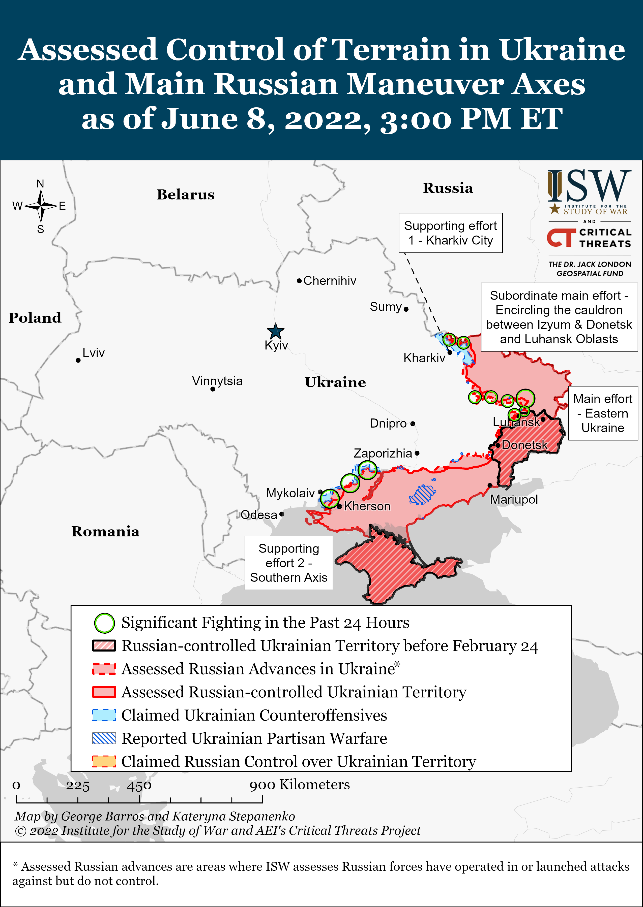
Russian military commanders continue to face force generation challenges. The Ukrainian Southern Operational Command reported that Russian military enlistment offices in Crimea are falsifying the results of mandatory medical exams administered during the summer conscription period to maximize the number of recruits. Russian police also arrested a man who threw a molotov cocktail and set fire to a local Crimean administration building in protest of the Russian invasion of Ukraine, likely indicating growing discontent with Russian war efforts in Crimea. ISW has previously reported that forced mobilization in the Donetsk and Luhansk People’s Republics (DNR and LNR) is exacerbating social tensions and sparking protests in Donbas. The Ukrainian General Staff also reported that unspecified elements of the 106th and 76th Guards Airborne Assault Divisions refused to participate in combat in Luhansk Oblast and returned to Russia. The 76th Guards Airborne Assault Division previously participated in assaults on Kyiv, Izium, and Popasna, which has likely led to the demoralization of troops. Key Takeaways Ukraine’s strategic dilemma in Sievierodonetsk: Stand and fight, or pull back, The New York Times asks? Just to enter Sievierodonetsk, Ukrainian soldiers run a gantlet of Russian artillery shells zeroed in on the only access route: a bridge littered with the burned husks of cars and trucks that didn’t make it. Ukraine’s leaders now face a key strategic decision: whether to withdraw from the midsize city and take up more defensible positions, or to remain and risk being boxed in if the bridge is blown up. It reflects the choices the country has had to make since the Russian invasion began, between giving ground to avert death and destruction in the short term, and holding out against long odds in hopes it will later pay off. In Sievierodonetsk, that calculation has taken on significance beyond the city’s limited military importance. In remarks to journalists on Monday, President Volodymyr Zelensky referred to Sievierodonetsk and its neighbor across the river, Lysychansk, as “dead cities” ravaged by Russian attacks and nearly empty of civilians. And yet he insisted there was a compelling reason to stay and fight: Ukraine’s position throughout the war has been that it intends to hold onto its sovereign territory, and not yield it to Moscow. Retreating now to better positions on higher ground across the Siverskyi Donets River, and then fighting to retake the city later, he said, would be harder and carry a higher price in bloodshed than holding on. […] It was a rare public rumination by Mr. Zelensky on strategic decision-making in the war, providing a window into the goals of his government and its military. Sievierodonetsk is the last major city in the breakaway region of Luhansk that the Russians have not taken; capturing it would give them near-total control of that enclave. There are other factors as well. Falling back could be demoralizing to Ukraine’s forces. And some Ukrainian soldiers said it is worth drawing out the phase of urban combat to inflict more casualties on the already depleted Russian forces, and possibly damage their morale. It was also possible Mr. Zelensky was aiding the military with misdirection by signaling one intention while quietly pursuing an opposite course of action. The government has not said how many military casualties Ukraine has suffered overall since the Russian leader Vladimir V. Putin ordered the invasion in February. But Mr. Zelensky said last week that in the recent, intense fighting, each day his country was losing 60 to 100 soldiers killed and 500 wounded. Russia’s defense minister, Sergei Shoigu, said Tuesday that 6,489 Ukrainian service members had been captured. Ukraine’s Interior Ministry this week estimated civilian casualties at 40,000 killed or wounded, though some government officials say the true figures are higher. Ukrainian officials said Tuesday that ruptured sewer and water pipes in the southern city of Mariupol, seized by Russia after a devastating siege, have created a risk of severe disease outbreaks that would raise the civilian toll. The battle for Sievierodonetsk, part of Luhansk and the broader Donbas region in the east, has raged now for weeks, and some Ukrainian soldiers have questioned why the army has not ordered a tactical retreat. […] The city lies on the mostly flat, eastern bank of the Siverskyi Donets. The western bank, in contrast, rises in a prominent hill that provides commanding views and firing positions. Earlier in the war, Ukrainian soldiers were surrounded in Mariupol and fought for weeks, eventually retreating to hold just a tiny pocket of ground in a steel factory complex where they sheltered in bunkers, before Mr. Zelensky ordered the holdouts to surrender rather than be killed. Ukrainian commanders decided to avert a smaller-scale version of that siege earlier this week in Sviatohirsk, a town lying on the low bank of the Siverskyi Donets. Trying to trap Ukrainian troops in the town, Russian forces had been firing artillery at their only remaining route across the river, a bridge near an Orthodox monastery that was also frequently hit. On Monday, the Ukrainian army pulled back, blew up the bridge and took up positions on the river’s high bank, Ukrainian officials said. […] As water starts flowing again to Crimea, Russia nears a major objective, The New York Times reports. “Russian forces have restored a piece of Ukrainian infrastructure vital to the “land bridge” that Moscow seeks to establish linking Russian territory to the Crimean Peninsula: a canal that supplies water from southern Ukraine to the peninsula, according to satellite images and a statement on Tuesday by the Kremlin’s defense minister, Sergei K. Shoigu. For years, the 250-mile-long Northern Crimean Canal had channeled water from Ukraine’s Dnipro River to the arid peninsula of Crimea. Built by thousands of construction workers from across the Soviet Union, it was a marvel of engineering, dropping about an inch for every mile for the first half of its length to keep the water flowing. All that changed after Russia, under President Vladimir V. Putin, annexed the peninsula in 2014. Ukraine responded by damming the canal with bags of sand and clay to prevent the now Russian-occupied peninsula from benefiting from the valuable freshwater. […] Ukrainian officials said that cutting off the water was one of the few levers at their disposal to inflict pain on Moscow after the annexation without using military force. For the Kremlin, the blockage of the canal was a vexing and expensive challenge. Crimea’s residents began to suffer chronic water shortages and occasional shut-offs at the tap.”


